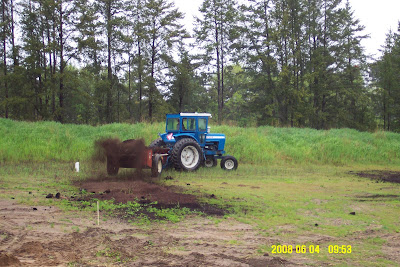Only instead of an 88 mile per hour time-traveling DeLorean, we have an 88 foot per minute distance-traveling manure spreader. Oh yeah.
Site repair continues at the cottage. Today was compost-spreading day. Altogether the site is more than an acre, so we rented Old MacDonald's manure spreader.

We're basically doing a mixture experiment with two different types of compost. The "expensive" kind is rotted horse manure @ $20/yard. The "cheap" kind is rotted sawdust @ $4/yard. (Delivered prices.)
We are motivated here by the permaculture principle of turning problems (like waste sawdust) into resources (like soil amendment.)
The hypothesis we are testing is: that this composted sawdust is like peat moss as a soil amendment, that is, it will help the soil retain water and, while its carbon/nitrogen ratio is high for compost, the soil microbes can only break it down slowly, so they won't tie up too much of the soil nitrogen needed by plants. As far as we know there is no standard lab test for this property, so we are testing it on the ground. (As I mentioned in a previous post, the two campus biologists, both with degrees and years of experience, had completely opposite instincts about this stuff.)
I divided the west field into three plots each about 68 feet by 90. The idea was to amend the south plot with sawdust only, the north plot with horse manure, and the middle plot with a 50/50 mix. All the plots would receive the same total amount of organic matter - 14 yards - which was my estimate of the amount needed to boost the soil organic matter percentage by two points (on a dry weight basis) to a depth of 8 inches (if it was tilled in uniformly.) Overall it probably ended up being amended more heavily - on the map the west field measured 0.58 acre, but on the ground, only 0.42 acre.
I think we more-or-less pulled this off. The tractor and spreader is a 30 foot long rig together and therefore kind of a blunt instrument in an 80 foot plot. Also, we don't have a good way of verifying how much material we actually got from the compost suppliers.
Here's Jolson driving the Ford and spreader, while Pigpen tries to spread the sawdust out more uniformly with the Cat:


The south plot was supposed to get 14 yards sawdust and the center plot 7, it probably ended up closer to 15 and 5, we ran a little short.
The total amount of horse manure applied to the north and center plots was probably about right. It was supposed to be 21 yards, we believe we had 50 to start with and we put a bit less than half the pile on it. It was supposed to be split 7 on the center and 14 on the north. Jolson kind of eyeballed that by driving the spreader faster over the center plot.
The plan is to chisel-plow through all three of the west field plots to decompact them from the earlier construction traffic. This will mix in the compost somewhat, and we can do soil tests to see what we actually got.
There are also two control areas on the south side of the cottage. One will get no compost but will be chisel-plowed, and one will get neither.
The rest of the site, mainly on the north and east sides of the cottage, we are basically just trying to get green with a drivable groundcover. Much of this half-acre area consists of very poor sandy subsoil. On this we put down 28-ish yards of the composted horse manure, which I estimated should be enough to boost the soil organic matter by two percentage points to a depth of six inches, if it was all tilled in uniformly. This area we will probably rototill.
We did get the lab test results back on the sawdust and the soil samples. Here are the hilites:
The west field soil had only 2% organic matter and a cation exchange capacity of 4. This is pretty bad, I think you'd like to see both of those numbers about twice that. The compost should double the organic matter.
The sandy subsoil had only 0.4% organic matter. The compost we added today should get it to about a minimum level to support plant life.
The soil along the south edge, closest to road, I had tested for lead. That was negative (less than 5 ppm, with 100-300 ppm being considered actionable.)
The sawdust was tested as compost, and it sure does look pretty bad on paper. The carbon/nitrogen ratio was 115:1, and the pH was acid (4.6). I did my own water-retention test on it, it held about twice its weight in water (6.5 oz dry -> 19 oz wet.)




No comments:
Post a Comment